Historic Gold Coins
 Best-selling coins incl. pre-1933 U.S. gold coins
Best-selling coins incl. pre-1933 U.S. gold coins
Historic gold coins were once legal tender but cannot be used as such any longer. Most respected government mints that issue gold coins today can look back upon a long and distinguished history. Some gold coins with historic roots are still minted today like the British Gold Sovereigns. However, most gold coins that started out in the 1800's or early 1900's saw their mintage run come to an end eventually. The American President Roosevelt's law from 1933 that made the private ownership of gold illegal in America had a huge impact on the trade and usage of gold coins, not only in America but also worldwide. That's why the American gold coins that are listed on this page are also often referred to as pre-1933 US gold coins.
The most important criteria for a gold coin to be listed on this page is that it is no longer minted. This section is labeled "Historic Gold Coins" and not "Pre-1933 Gold Coins" since it encompasses coins that were minted sometime between the 1800's until the 1980's. The latter is true for the South African 1 and 2 Gold Rands that were only replaced by smaller fractional denominations of the world-famous Gold Krugerrands in 1983.
Not all gold coins listed on this page are still commonly traded today. Some have even become extremely rare like the Canadian George V gold coins that had never been minted in huge quantities anyway. Other historic gold coins that had once been minted in the millions are still quite easy to obtain today. That is of course not true for all years of their mintage. As a general rule you could say that the higher the total mintage of a certain coin was, the closer to the gold spot price it will be traded today. Some historic gold coins in their used condition (perhaps with scratches or red spots) can be quite a bargain compared with contemporary bullion coins of a similar gold weight.
Consider yourself very lucky if you find/inherit one of these coins in almost perfect condition. Such a coin would have a much higher value that could be multiples of its melt value. Collectors worldwide are constantly looking for such pristine coins that will see a further boost in value if they're certified by a coin grading service like the NGC or PCGS. Most historic gold coins were once also minted as proof coins. The extremely low proof mintage of most historic gold coins has seen some of the few surviving specimens sold at auctions for millions of dollars!!! Finally, there are also special limited-mintage versions of some historic US gold coins (for example the $20 Liberty Gold Double Eagles with a Paquet reverse) which generally have a considerable numismatic value.
The selection of coins that is introduced here is limited to the most popular and most commonly traded historic gold coins. Other rarer historic gold coins like for example the King Otto Marks you will periodically find introduced in our blog. The coins that are listed on this page were produced by some of the most respected minting institutions in the world. Click on the provided links to buy these coins from respected dealers online, compare current prices or just simply find out more information.
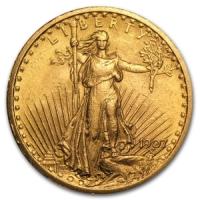
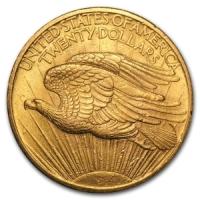
Saint-Gaudens Gold Double Eagles
The name of these coins refers to the US Mint sculptor Augustus Saint-Gaudens who designed them. The $20 Saint-Gaudens Gold Double Eagles succeeded the $20 Liberty Gold Double Eagles in 1907. The coins depict Lady Liberty on the obverse and a flying eagle with the sun on the reverse. The US Mint produced the new coins from 1907 to 1916 and then again from 1920 to 1933. The coins were struck at the US Mint facilities in Philadelphia, San Francisco and Denver. Their composition is 90% gold and 10% copper with each coin containing 0.9675 oz of gold. More than 70 million Saint-Gaudens Double Eagle coins were minted.
The Saint-Gaudens Gold Double Eagle page gives more information about the coins and allows you to compare current prices.
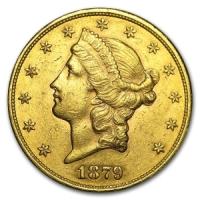
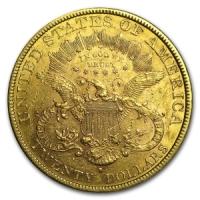
Liberty Gold Double Eagles
The $20 Liberty Gold Double Eagles were the predecessors of the $20 Saint-Gaudens Gold Double Eagles. The US Mint produced the coins from 1849 to 1907. They were struck at the US Mint facilities in Philadelphia, New Orleans, San Francisco, Carson City and Denver. Their composition is 90% gold and 10% copper with each coin containing 0.9675 oz of gold. Almost 104 million Liberty Double Eagles were minted. The coins depict a leftward facing Lady Liberty in profile on the obverse and an eagle that is holding a shield on the reverse. Three main coin subtypes and several additional varieties (for example the coins with a modified Paquet reverse) exist.
The Liberty Gold Double Eagle page gives more information about the coins and allows you to compare current prices.
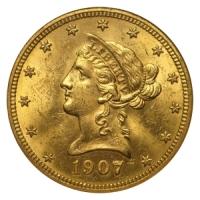
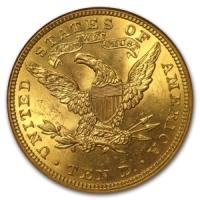
Liberty Gold Eagles
The $10 Liberty Gold Eagles were the predecessors of the $10 Indian Gold Eagles. The US Mint produced them from 1838 to 1907. The coins were struck at the US Mint facilities in Philadelphia, New Orleans, San Francisco, Carson City and Denver. They are composed of 90% gold and 10% copper with each coin containing 0.48375 oz of gold. Close to 43 million Liberty Eagle coins were minted. The design of the coins is the same as that of the bigger Double Eagles, depicting a leftward facing Lady Liberty in profile on the obverse and an eagle that is holding a shield on the reverse.
The Liberty Gold Eagle page gives more information about the coins and allows you to compare current prices.
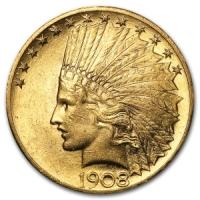
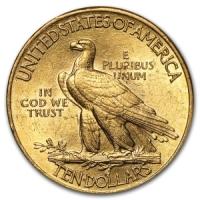
Indian Gold Eagles
The $10 Indian Gold Eagles succeeded the $10 Liberty Gold Eagles. The US Mint produced the new coins with years of interruption from 1907 to 1933. The coins were struck at the US Mint facilities in Philadelphia, San Francisco and Denver. They are composed of 90% gold and 10% copper with each coin containing 0.48375 oz of gold. Close to 15 million Indian Head Gold Eagles were minted. However, only a tiny amount were minted in proof condition at the Philadelphia facility. The coins depict a leftward facing Lady Liberty wearing a Native American headdress on the obverse and an eagle standing on a bundle of arrows with an olive branch on the reverse.
The Indian Gold Eagle page gives more information about the coins and allows you to compare current prices.
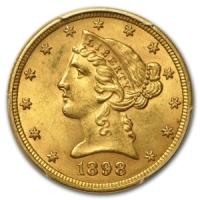
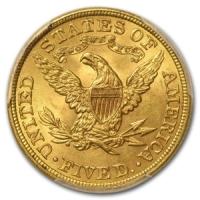
Liberty Gold Half Eagles
The $5 Liberty Gold Half Eagles were the predecessors of the $5 Indian Gold Half Eagles. The US Mint produced them from 1839 to 1908. The coins were struck at the US Mint facilities in Philadelphia, New Orleans, San Francisco, Carson City, Charlotte, Dahlonega and Denver, making them the only US coins that were produced at 7 different mint facilities. Their composition is 90% gold and 10% copper with each coin containing 0.24187 oz of gold. Close to 61 million Liberty Half Eagles were minted. However, only a tiny amount were minted in proof condition at the Philadelphia facility. The obverse side of the coins depicts Lady Liberty in profile and an eagle holding a shield appears on the reverse.
The Liberty Gold Half Eagle page gives more information about the coins and allows you to compare current prices.
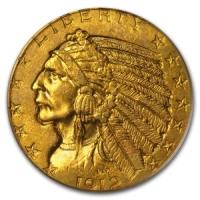
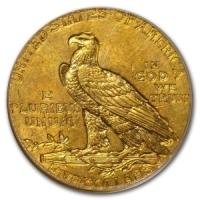
Indian Gold Half Eagles
The Indian Half Eagles succeeded the Liberty Half Eagles in 1908. The US Mint produced the $5 Indian Gold Half Eagles with years of interruption from 1908 to 1929. The coins were struck at the US Mint facilities in Philadelphia, San Francisco, New Orleans and Denver. They are composed of 90% gold and 10% copper with each coin containing 0.24187 oz of gold. About 14 million coins were minted. However, only a tiny amount were minted in proof condition at the Philadelphia facility. The obverse side of the coins shows a Native American Indian Chief wearing a traditional headdress and an eagle standing on a bundle of arrows and an olive branch is depicted on the reverse.
The Indian Gold Half Eagle page gives more information about the coins and allows you to compare current prices.
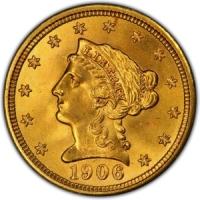
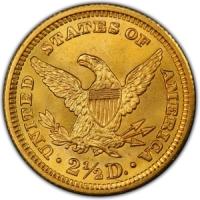
Liberty Gold Quarter Eagles
The $2.50 Liberty Gold Quarter Eagles were the predecessors of the $2.50 Indian Gold Quarter Eagles. The US Mint produced them from 1840 to 1907. The coins were struck at the US Mint facilities in Philadelphia, New Orleans, San Francisco, Charlotte and Dahlonega. Their composition is 90% gold and 10% copper with each coin containing 0.12094 oz of gold. Close to 12 million Liberty Quarter Eagles were minted. However, only a tiny amount were minted in proof condition at the Philadelphia facility. Lady Liberty is shown in profile on the obverse side of the coins and an eagle that is holding a shield can be seen on the reverse.
The Liberty Gold Quarter Eagle page gives more information about the coins and allows you to compare current prices.
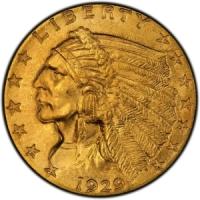
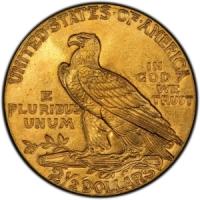
Indian Gold Quarter Eagles
The $2.50 Indian Gold Quarter Eagles succeeded the $2.50 Liberty Gold Quarter Eagles in 1908. The US Mint produced them with a period of interruption from 1908 to 1929. The coins were struck at the US Mint facilities in Philadelphia and Denver. Their composition is 90% gold and 10% copper with each coin containing 0.12094 oz of gold. More than 7 million Indian Quarter Eagles were minted. However, only a small amount were minted in proof condition at the Philadelphia facility. The obverse of the coins shows a Native American Indian Chief wearing a traditional headdress. An eagle that is standing on a bundle of arrows and an olive branch can be seen on the reverse.
The Indian Gold Quarter Eagle page gives more information about the coins and allows you to compare current prices.
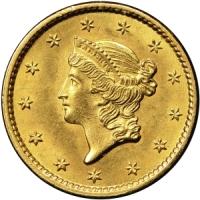
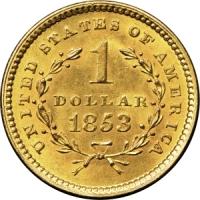
Liberty Gold Dollars
The $1 Liberty Gold Dollars were the predecessors of the $1 Indian Head Gold Dollars. The US Mint produced them from 1849 to 1854. The coins were struck at the US Mint facilities in Philadelphia, New Orleans, San Francisco, Charlotte and Dahlonega. Their composition is 90% gold and 10% copper with each coin containing 0.04837 oz of gold. About 12.6 million Liberty Head Gold Dollars were minted. A total of only 7 proof coins are believed to have been minted in 1849. No additional proof coins were minted in the following years. A profile of Lady Liberty appears on the obverse and a laurel wreath that is tied with a bow can be seen on the reverse.
The Liberty Gold Dollar page gives more information about the coins and allows you to compare current prices.
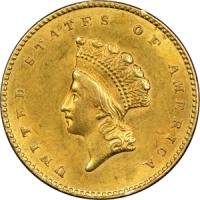
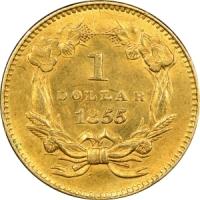
Indian Head Gold Dollars
The $1 Indian Head Gold Dollars succeeded the $1 Liberty Gold Dollars in 1854. The US Mint produced the new coins from 1854 to 1889. Two types of the coin exist that distinguish themselves by the size of the portrait on the obverse side. The coins were struck at the US Mint facilities in Philadelphia, New Orleans, San Francisco, Charlotte and Dahlonega. Their composition is 90% gold and 10% copper with each coin containing 0.04837 oz of gold. The coins' obverse shows Lady Liberty wearing a Native American headdress. Almost 7 million Indian Princess Gold Dollars were minted. An agricultural wreath of corn, cotton, wheat and tobacco that is tied with a bow can be seen on the reverse.
The Indian Gold Dollar page gives more information about the coins and allows you to compare current prices.
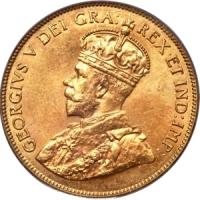
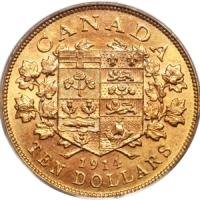
Canadian George V Gold Coins
The Royal Canadian Mint produced $5 and $10 George V gold coins between 1912 and 1914. The coins were the first Canadian gold coins since the mint in Ottawa had just been opened in 1908 as a branch mint of London's Royal Mint. Composed out of 90% gold and 10% copper, each $10 coin contains 0.4837 oz of gold and each $5 coin 0.2419 oz. The Royal Canadian Mint recently made about 30,000 such coins available that had been in storage at Bank of Canada vaults. The obverse side of the coins depicts King George V in profile wearing his ceremonial robe and royal crown. A shield bearing the Arms of the Dominion of Canada is depicted on the reverse side.
The Canadian George V Gold Coin page gives more information about the coins and allows you to compare current prices.
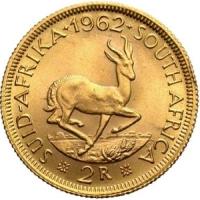
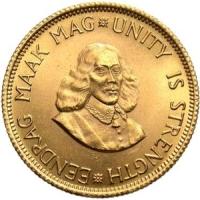
South African Rand Gold Coins
The SA Mint produced South African Rand gold coins in the denominations of 1 Rand and 2 Rand between 1961 and 1983. They are available as almost uncirculated, brilliant uncirculated and proof coins. The 1 and 2 South African Gold Rand contain 91.67% gold with respective actual fine gold weights of 0.1177 oz and 0.2354 oz. The obverse side of the coins shows a portrait of the former Dutch commander of the Cape Jan van Riebeeck. South Africa's springbok antelope can be seen on the reverse. The coins were eventually replaced by the fractional 1/10 oz and 1/4 oz Gold Krugerrand coins that also bear the iconic springbok design on their reverse.
The South African Gold Rand page gives more information about the coins and allows you to compare current prices.
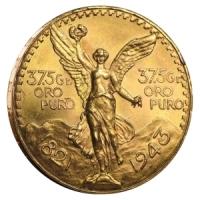
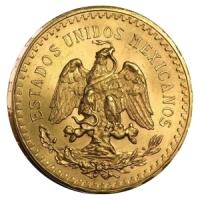
Mexican Centenario Gold Coins
The Casa de Moneda de México produced the Mexican Centenario gold coins between 1921 and 1947. The name Centenario comes from their dedication to the 100th anniversary of Mexico gaining its independence from Spain, its former colonial master. The coins are composed of 90% gold and 10% copper and have an actual gold weight of 1.2057 oz and a 50 Peso face value. With a diameter of 37.1 mm, the Mexican 50 Peso gold coins are the largest and heaviest of the different Mexican gold coins. Their obverse side shows Mexico's Angel of Independence with a laurel wreath and broken chains. An eagle perched on top of a prickly pear cactus holding a serpent can be seen on the reverse.
The Mexican Gold Centenario page gives more information about the coins and allows you to compare current prices.
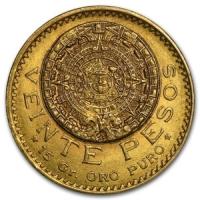
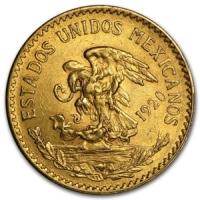
Mexican Gold 20 Pesos
Many investors and collectors consider the intricately designed Mexican Gold 20 Pesos to be one of the most beautiful gold coins of all time. The Casa de Moneda de México produced them between 1917 and 1921 and in 1959. The coins that are nicknamed 'Aztecas' are considerably smaller than the 'Centenario' Mexican 50 Peso gold coins. The Mexican 20 Peso gold coins are composed of 90% gold and 10% copper and have an actual gold weight of 0.4823 oz. A total of 6,174,000 such coins were minted. The obverse side of the coins shows the Aztec Calendar Stone. The rendering of the eagle & snake design on the reverse is different from that on the Centenarios.
The Mexican Gold Azteca page gives more information about the coins and allows you to compare current prices.
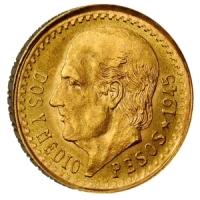
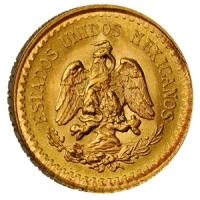
Mexican Gold Hidalgo
The Casa de Moneda de México produced the Mexican Gold Hidalgo between 1905 and 1959 in the denominations of 10 Peso (0.2411 oz), 5 Peso (0.1205 oz), 2.5 Peso (0.0603 oz) and 2 Peso (0.0482 oz). Not all denominations were minted in every year and there were various mintage interruptions during this period. The coins are composed of 90% gold and 10% copper. The four smallest denominations of the Mexican Gold Pesos are named after Don Miguel Hidalgo y Costilla whose portrait appears on the obverse of all except the 2 Peso coins. The reverse of the coins shows an eagle on top of a cactus holding a serpent, just like on the Centenarios.
The Mexican Gold Hidalgo page gives more information about the coins and allows you to compare current prices.
information only without price comparison:
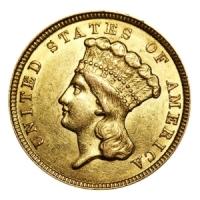
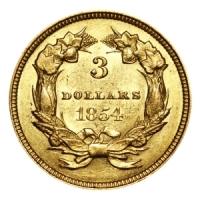
3 Dollar Indian Gold Coins
The US Mint produced the 3 Dollar Indian gold coins between 1854 and 1889. The coins are basically identical in design to the Indian Head Gold Dollars, depicting Lady Liberty with a Native American headdress on the obverse and an agricultural wreath of corn, cotton, wheat and tobacco on the reverse. Production of the coins was done at the US Mint facilities in Philadelphia, New Orleans, San Francisco and Dahlonega. They are made out of 90% gold and 10% copper and each coin contains 0.14512 oz of gold. According to the 1934 annual report of the US Mint, a total of 539,792 such Three-Dollar gold pieces had been produced. However, these coins are extremely rare nowadays.
The page for the 3 Dollar Indian gold coins gives more information about these rare coins.
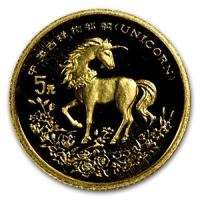
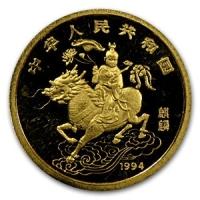
Chinese Gold Unicorns
The China Gold Coin Incorporation minted Unicorn coins out of 99.9% pure gold between 1994 and 1997 in the denominations of 1/20 oz (5 Yuan face value), 1/10 oz (10 Yuan), 1/4 oz (25 Yuan), 1/2 oz (50 Yuan), 1 oz (100 Yuan), 5 oz (500 Yuan) and 1 kg (2,000 Yuan). All of these denominations were minted in 1994 and 1996. In 1995, the 1 kg gold coin was not minted. Only 1/10 oz Unicorn gold coins were minted in 1997. All Chinese Gold Unicorns display images of two mythical beasts, a Unicorn on the obverse and a Chinese kirin on the reverse. Only the 1 kg coin from 1994 is a bit different in that it shows the kirin on the obverse and a Chinese building on the reverse. Additionally, there were bimetallic Unicorn coins (1/4 oz inner gold core + 1/8 oz silver outer ring; face value of 25 Yuan) issued in 1994 and 1995.
Read our blog article for more information about these coins.
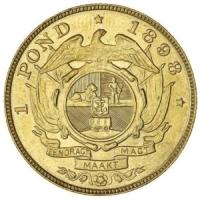
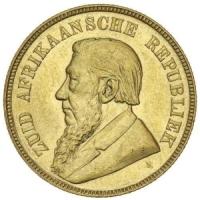
South African Kruger Ponds
The 91.67% pure South African Kruger Ponds were minted in two denominations, the Kruger Pond (0.2352 oz) and the Half-Pond (0.1177 oz). The Kruger Pond is the larger of the two coins with a diameter of 22 mm and 1.56 mm in thickness. Altogether, more than 2.2 million Kruger Pond gold coins were minted by the South African Boers between 1892 and 1900. The Half-Ponds (diameter: 19.4 mm; thickness: 1.55 mm) were minted from 1892 to 1897. Their total mintage was substantially lower with only 362,982 coins. Both the Pond and the Half-Pond display Otto Schultz' portrait of the first South African President Paul Kruger on the obverse. That same portrait is still used on the famous Gold Krugerrand coins today. The reverse side of the coins shows the coat of arms of the South African Republic.
Read our blog article for more information about these coins.